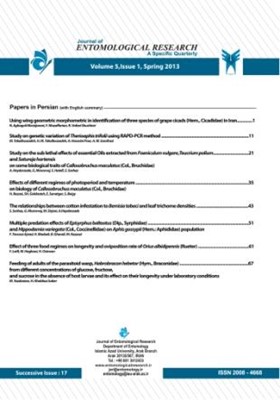The relationships between cotton infestation to Bemisia tabaci and leaf trichome densities
Subject Areas : entomology and othea arthropodsS. Sarbaz 1 , G. Moravvej 2 , M. Sirjani 3 , A. Heydarzade 4
1 - Ph.D. student, Department of Plant Protection, Islamic Azad University, Arak Branch, Arak, Iran
2 - Department of Plant Protection, Faculty of Agriculture, Ferdowsi University of Mashhad, Iran
3 - Department of Plant Protection, Cotton Research Station East Countries, Kashmar, Iran
4 - Gratuated Student, Department of Plant Protection, Faculty of Agriculture, Ferdowsi University of Mashhad, Iran
Keywords:
Abstract :
The relationship between densities of leaf trichomes and number of sweetpotato whitefly, Bemisia tabaci (Gennadius) was investigated on six genotypes of upland cotton, Gossypium hirsutum L. (Mehr, Varamin, Sahel, Khordad, Okra and Red okra) genotypes and one genotype of sea island cotton, Gossypium barbadence (Termus 14) at Cotton Research Station Kashmar, east of Iran, during cropping season in 2009. The result indicated that Termus 14 supported the highest numbers of eggs, nymphs and adults, and also had the highest numbers of trichomes compared to other genotypes.While the genotypes Okra and Red okra with the least numbers of trichomes on leaf surface suppprted the least numbers of various stages of whitefly. Therefore, there was a significant and positive relationship between leaf trichome densities and whitefly population. It is concluded that the genotypes with glabrous leaves cotton may reduce the whitefly population on cotton.


